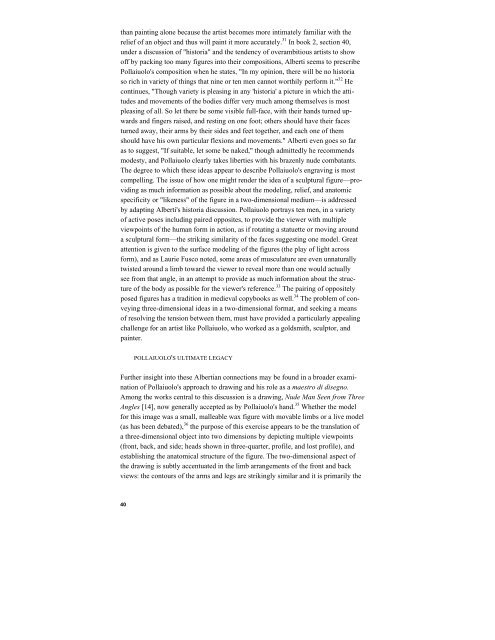Battle of the Nudes
Battle of the Nudes
Battle of the Nudes
You also want an ePaper? Increase the reach of your titles
YUMPU automatically turns print PDFs into web optimized ePapers that Google loves.
than painting alone because <strong>the</strong> artist becomes more intimately familiar with <strong>the</strong><br />
relief <strong>of</strong> an object and thus will paint it more accurately. 31 In book 2, section 40,<br />
under a discussion <strong>of</strong> "historia" and <strong>the</strong> tendency <strong>of</strong> overambitious artists to show<br />
<strong>of</strong>f by packing too many figures into <strong>the</strong>ir compositions, Alberti seems to prescribe<br />
Pollaiuolo's composition when he states, "In my opinion, <strong>the</strong>re will be no historia<br />
so rich in variety <strong>of</strong> things that nine or ten men cannot worthily perform it." 32 He<br />
continues, "Though variety is pleasing in any 'historia' a picture in which <strong>the</strong> atti-<br />
tudes and movements <strong>of</strong> <strong>the</strong> bodies differ very much among <strong>the</strong>mselves is most<br />
pleasing <strong>of</strong> all. So let <strong>the</strong>re be some visible full-face, with <strong>the</strong>ir hands turned up-<br />
wards and fingers raised, and resting on one foot; o<strong>the</strong>rs should have <strong>the</strong>ir faces<br />
turned away, <strong>the</strong>ir arms by <strong>the</strong>ir sides and feet toge<strong>the</strong>r, and each one <strong>of</strong> <strong>the</strong>m<br />
should have his own particular flexions and movements." Alberti even goes so far<br />
as to suggest, "If suitable, let some be naked," though admittedly he recommends<br />
modesty, and Pollaiuolo clearly takes liberties with his brazenly nude combatants.<br />
The degree to which <strong>the</strong>se ideas appear to describe Pollaiuolo's engraving is most<br />
compelling. The issue <strong>of</strong> how one might render <strong>the</strong> idea <strong>of</strong> a sculptural figure—pro-<br />
viding as much information as possible about <strong>the</strong> modeling, relief, and anatomic<br />
specificity or "likeness" <strong>of</strong> <strong>the</strong> figure in a two-dimensional medium—is addressed<br />
by adapting Alberti's historia discussion. Pollaiuolo portrays ten men, in a variety<br />
<strong>of</strong> active poses including paired opposites, to provide <strong>the</strong> viewer with multiple<br />
viewpoints <strong>of</strong> <strong>the</strong> human form in action, as if rotating a statuette or moving around<br />
a sculptural form—<strong>the</strong> striking similarity <strong>of</strong> <strong>the</strong> faces suggesting one model. Great<br />
attention is given to <strong>the</strong> surface modeling <strong>of</strong> <strong>the</strong> figures (<strong>the</strong> play <strong>of</strong> light across<br />
form), and as Laurie Fusco noted, some areas <strong>of</strong> musculature are even unnaturally<br />
twisted around a limb toward <strong>the</strong> viewer to reveal more than one would actually<br />
see from that angle, in an attempt to provide as much information about <strong>the</strong> struc-<br />
ture <strong>of</strong> <strong>the</strong> body as possible for <strong>the</strong> viewer's reference. 33 The pairing <strong>of</strong> oppositely<br />
posed figures has a tradition in medieval copybooks as well. 34 The problem <strong>of</strong> con-<br />
veying three-dimensional ideas in a two-dimensional format, and seeking a means<br />
<strong>of</strong> resolving <strong>the</strong> tension between <strong>the</strong>m, must have provided a particularly appealing<br />
challenge for an artist like Pollaiuolo, who worked as a goldsmith, sculptor, and<br />
painter.<br />
POLLAIUOLO'S ULTIMATE LEGACY<br />
Fur<strong>the</strong>r insight into <strong>the</strong>se Albertian connections may be found in a broader exami-<br />
nation <strong>of</strong> Pollaiuolo's approach to drawing and his role as a maestro di disegno.<br />
Among <strong>the</strong> works central to this discussion is a drawing, Nude Man Seen from Three<br />
Angles [14], now generally accepted as by Pollaiuolo's hand. 35 Whe<strong>the</strong>r <strong>the</strong> model<br />
for this image was a small, malleable wax figure with movable limbs or a live model<br />
(as has been debated), 36 <strong>the</strong> purpose <strong>of</strong> this exercise appears to be <strong>the</strong> translation <strong>of</strong><br />
a three-dimensional object into two dimensions by depicting multiple viewpoints<br />
(front, back, and side; heads shown in three-quarter, pr<strong>of</strong>ile, and lost pr<strong>of</strong>ile), and<br />
establishing <strong>the</strong> anatomical structure <strong>of</strong> <strong>the</strong> figure. The two-dimensional aspect <strong>of</strong><br />
<strong>the</strong> drawing is subtly accentuated in <strong>the</strong> limb arrangements <strong>of</strong> <strong>the</strong> front and back<br />
views: <strong>the</strong> contours <strong>of</strong> <strong>the</strong> arms and legs are strikingly similar and it is primarily <strong>the</strong><br />
40
















